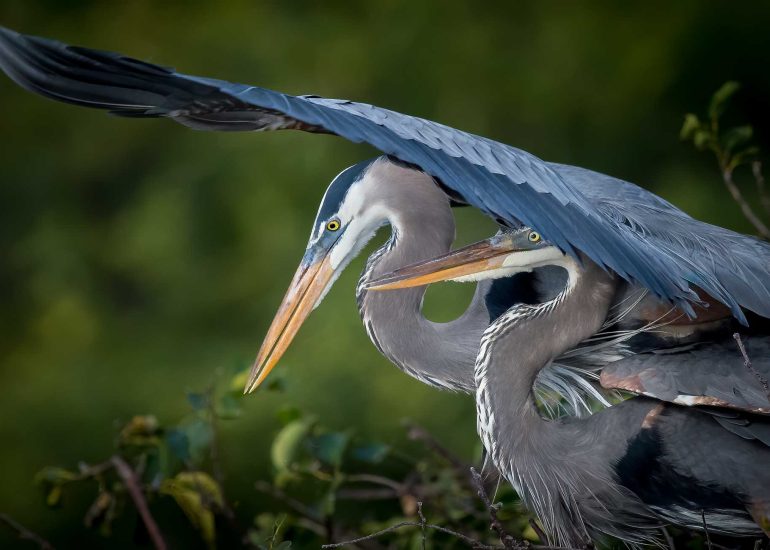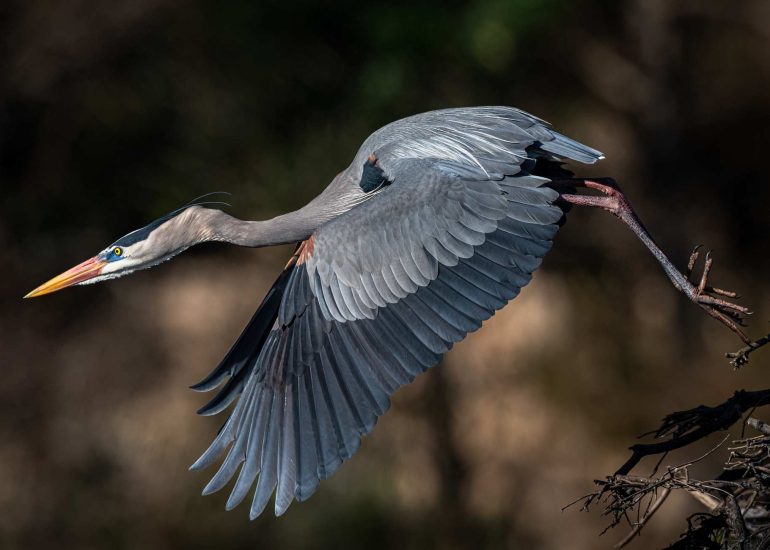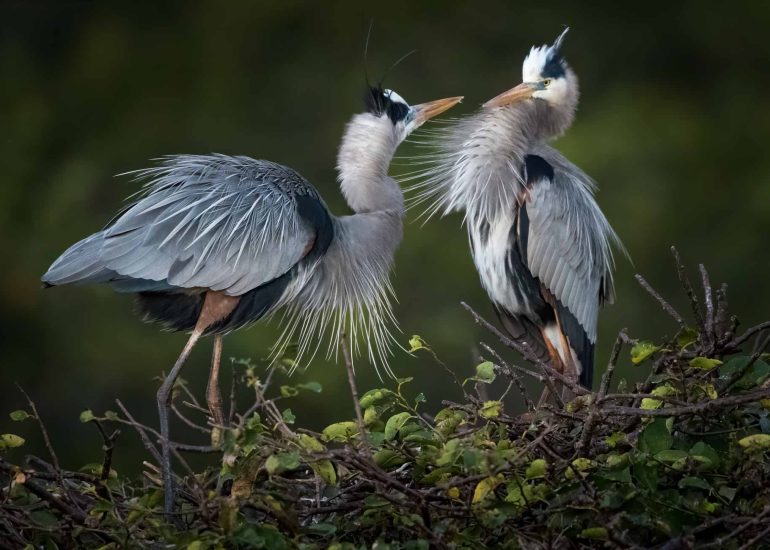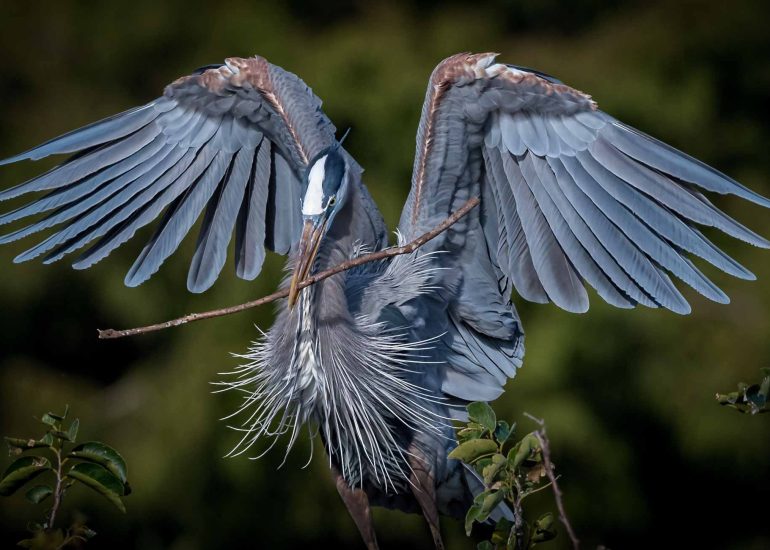
The Great Blue Heron
Great Blue Herons (Ardea herodias)—what spectacularly marvelous creatures. Living in South Florida where Blue Herons live, breed, and nest, I’ve had the privilege of photographing dozens of these whimsically majestic birds during every season. Whether foraging for its next meal or slowly gliding along the wetlands with slow, swooshing wingbeats and a head hunched back onto its shoulders, the Great Blue Heron is as impressive as it is ceremonious. I have to say that of all the birds I photograph, I find them to be among the most entertaining, second only to the Reddish Egret.

It’s true that capturing the perfect image of a Great Blue Heron can prove to be quite challenging, even for the most seasoned paparazzo. Birds are inherently skittish and so getting close enough to fill the frame is an art in and of itself. Exceptional bird and wildlife photography takes time, a great deal of patience, and thoughtful planning.
Blue Herons fish primarily at dawn and dusk, so the golden hours are the timeframes of choice when it comes to getting a chance at a picturesque photo—the exquisite lighting is just a bonus.
If you’ve landed on this page either for information or professional Great Blue Heron pictures, you’re in the right place.
All About Great Blue Herons
- Scientific Name: Ardea herodias
- Order: Pelecaniformes
- Family: Ardeidae (herons, egrets, and bitterns)
- Conservation Status: Stable
- Size & Wingspan: 4 feet tall; 6–7-foot wingspan
- Lifespan: 15 years on average
Identification
Great Blue Herons are the largest herons in North America standing at approximately four feet tall with a six-to-seven-foot wingspan. Despite their tall stature, they weigh only five to six pounds due to birds’ hollow bone structure.

Blue Herons are wading birds, adorned with long legs, an easily identifiable ‘S’ curved neck, and broad rounded wings. These regal avians have subtle blue-gray feathers with a white head and a distinctive dark blue patch around the head and eyes. In poor lighting, their shaggy plumage can appear dark gray or even black. When in flight, the upper side of their wings are two-toned—darker on the flight feathers and light on the forewing.
As for their beaks, Blue Herons sport straight dagger-like bills to aid in easily spearing fish and other small to medium-sized prey. An adult also has thin black feathers tucked back behind their heads.
Habitat
 The ‘Great Blue’ as some call it, is native to Florida, making them year-round residents of the Sunshine State. However, they’re one of the most widely recognized birds in the U.S. and touch every state in the country either permanently or seasonally during periods of migration.
The ‘Great Blue’ as some call it, is native to Florida, making them year-round residents of the Sunshine State. However, they’re one of the most widely recognized birds in the U.S. and touch every state in the country either permanently or seasonally during periods of migration.
Their prominence can be attributed to their high adaptation of various climates and because of this, they are able to thrive in swamps, lakeshores, shallow beaches, inland rivers, coastal bays, mangroves, and marshes from Alaska to Central America.
Since the Great Blue Heron lives, breeds, and nests in South Florida, I get to take images of them during every season and capture them at these various stages. Talk about animated! These birds could have their own cartoon sitcom, particularly the juveniles! I laugh just thinking about it.



Behavior and Feeding
Great Blue Herons are naturally statuesque. They usually stand motionless while silently scouring for prey or wading belly-deep with long, meticulous steps. They may move slowly, but don’t be fooled. Blue Herons can strike in an instant to grab a fish, turtle, or even a gopher. As mentioned earlier, they hunt during both the day and at night.

The diet of a Great Blue varies depending on where they are, but they tend to eat mostly smaller fish, frogs, turtles, insects, crabs, lizards, iguanas, snakes, rodents, and even smaller birds. There have been reports of Blue Herons even eating stingrays!
Nesting and Displays
Great Blue Herons tend to nest and breed in colonies known as “heronries” with others of the same species. Occasionally you’ll also find them with other wading birds and never isolated or alone. These colonies typically consist of 500 or more nests built 100 feet or more off the ground.
For some birds like these herons, nesting is a genuine partnership, at least while the relationship lasts. It begins with the male heron choosing a nest site and putting on displays for female suitors. They don’t mate for life, but they do partake in extravagant courting rituals to attract their potential next partner and build a nest together.

These displays consist of animated, dance-like movements; stretching their necks upward with their bills pointing straight toward the sky, circular flights over heronries, moaning calls, preening, twig exchanging, twig shaking, crest raising, and even battles of the bill. Fights over female blue herons are common, but they never result in death.

Both parties are involved with the nest making. The males find and present the twigs, the females weave them together and soften the inside by padding it with leaves, moss, and grass. Once the pair have finished their elaborate dances of affection and initial nest construction, the male and female heron have a bond strong enough to begin the process of raising their hatchlings together. It’s romantic and quirky at the same time.

Blue Heron nests are large—approximately three feet wide and three feet high—and built high up in trees to protect them from predators. To build the nest takes about a week, but the process of construction and insulating lasts during the 28-day incubation period and even after their eggs have hatched. During this time, both the male and female share in the responsibilities of incubation and care of the hatchlings. How progressive!
Some of my best Great Blue Heron images come from these amusing and repetitive rituals. The key is having enough patience to get incredible and candid shots.

Life Cycle
The average lifespan of a Great Blue Heron is about 15 years, although there are reports to them living to be as old as 23. As holds true with many animals, they’re most vulnerable when they are young. In fact, more than half of Blue Herons will die before they turn one year old—often before they’ve hatched—to predators like raccoons, horned owls, vultures, ravens, red-tailed hawks, and eagles.
Great Blue Heron and Wildlife Photography
I love learning about and taking pictures of birds and other South Florida wildlife. There is something truly exhilarating about watching them build a nest, find a mate, forage, and feed. More than that, I love being able to share my passion—and images—with other wildlife photography enthusiasts. To check out more of my work on Great Blue Herons and other South Florida wildlife, visit the Dan Power Gallery.
Did you love the images you see here? Everything on my blogs is available for purchase on the Dan Power Gallery online store with several framing, size, and surface options.










